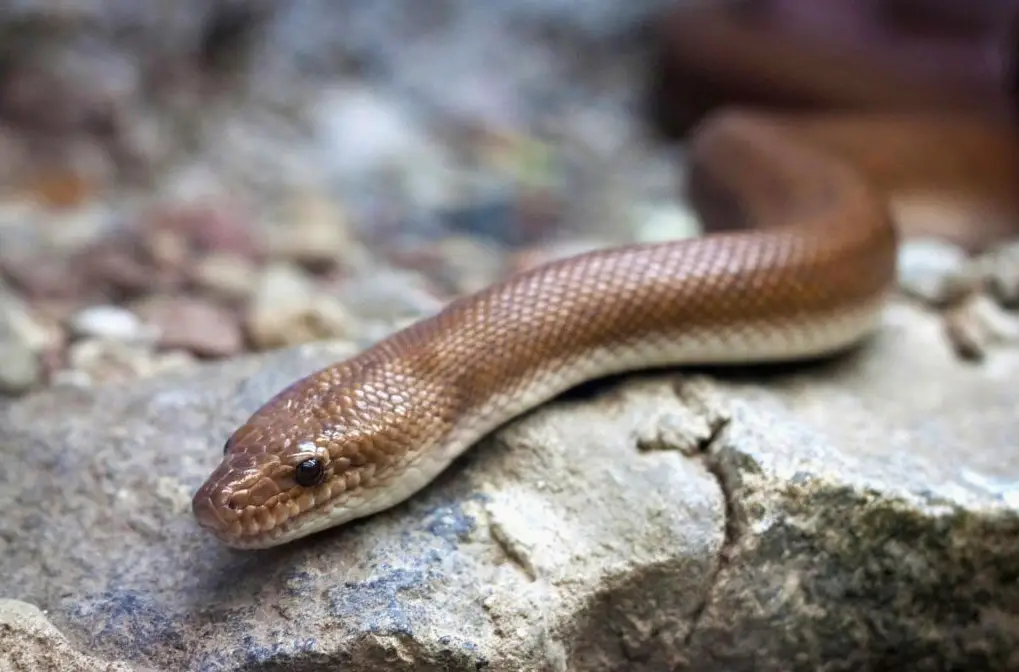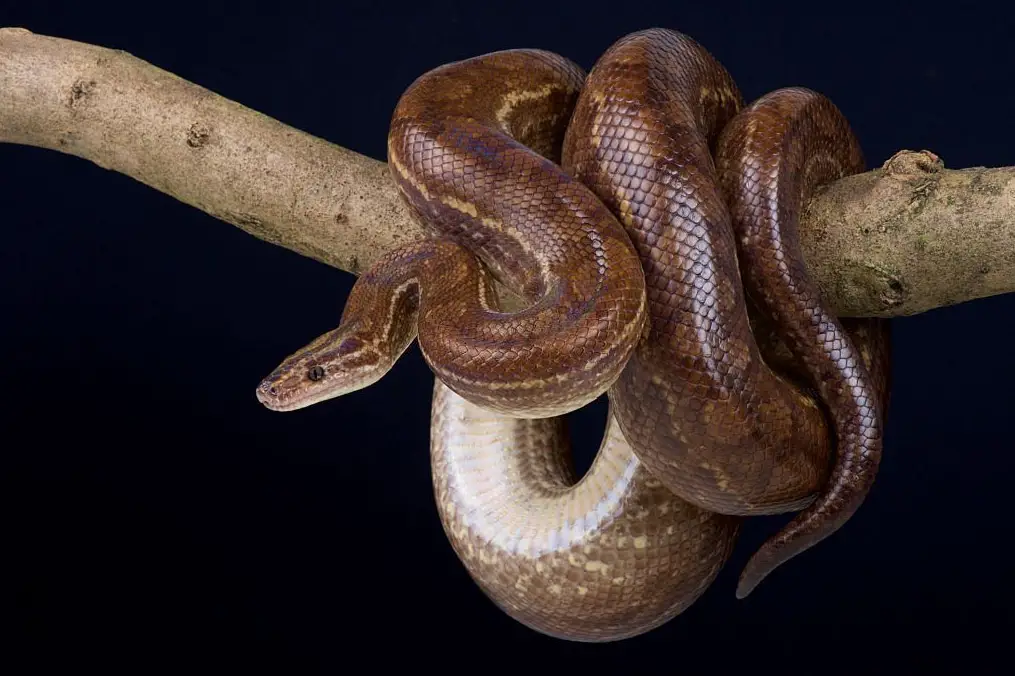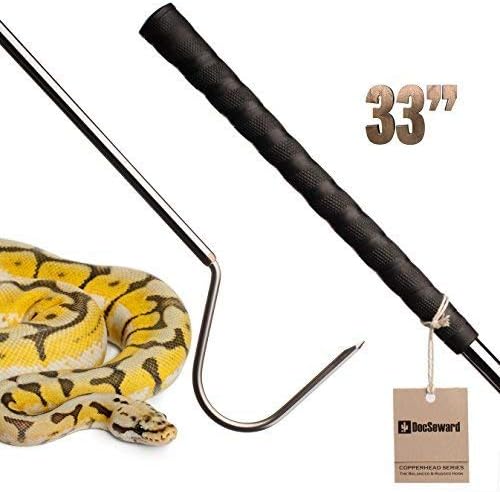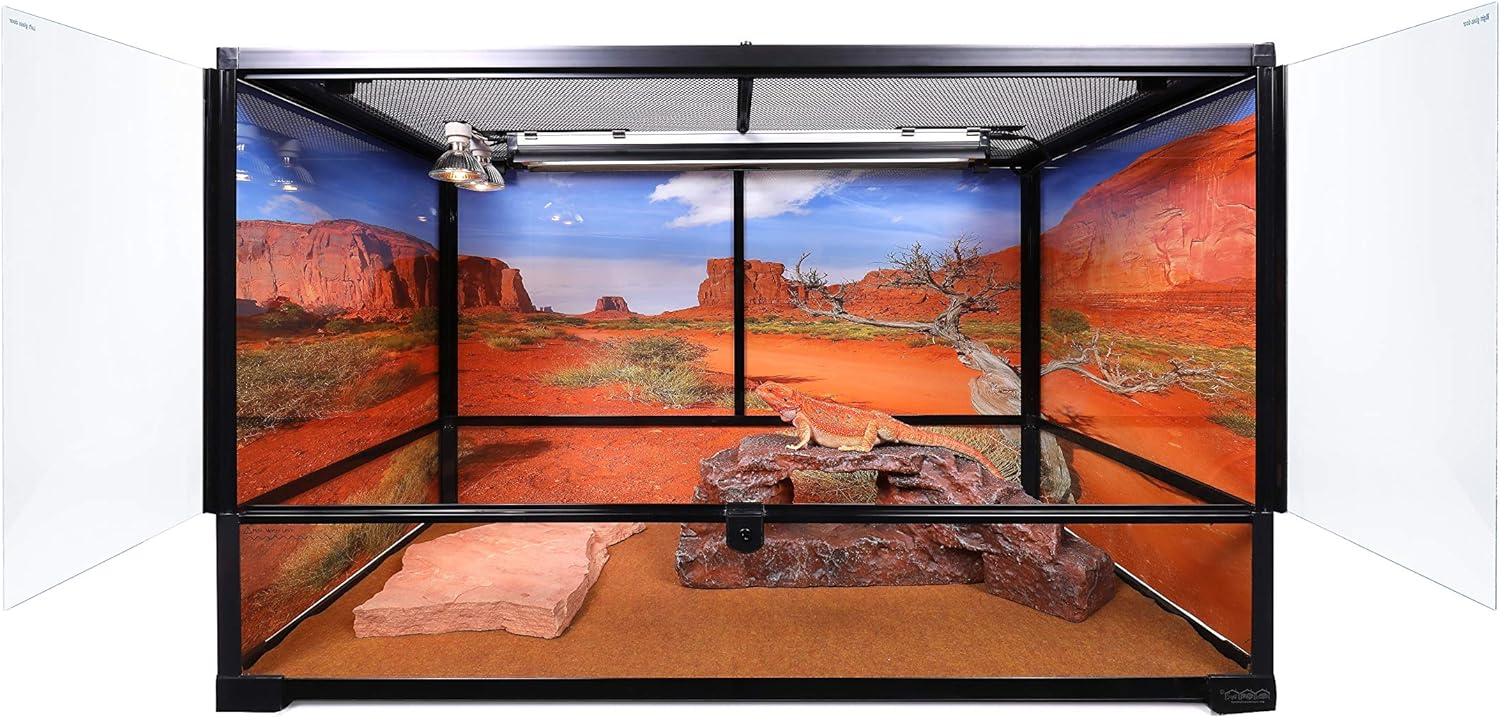Colombian rainbow boas are one of the modern reptile industry’s most popular pet snakes. They are not only strong and beautiful but also very easy to care for once you get the hang of doing so and have done a bit of research.
Before buying your own rainbow boa, it’s important to understand the level of care required, as well as the ins and outs of what makes this snake a great pet for some and a not-so-great pet for others.
Today, we’re diving into how to care for Colombian rainbow boas. We’ll go in-depth into their enclosures, diet, lifespan, size, temperament, and much more.
| Common Name: | Colombian Rainbow Boa |
| Scientific Name: | Epicrates Maurus |
| Natural Habitat: | South America |
| Adult Size: | 5 to 6 ft |
| Lifespan: | 20+ years |
| Diet: | Small mammals/rodents |
| Experience Level: | Intermediate |
| Enclosure Size: | 3 ft x 2 ft x 2ft |
Overview
The Colombian rainbow boa (Epicrates maurus) is a non-venomous species of constrictor that’s native to the Amazon region of South America. An alternative name for this snake is the brown rainbow boa. Colombian rainbow boas are very similar to Brazilian rainbow boas, with very few differences setting the two species apart.
These boas reach a moderate size and require a generous humidity level, a large enclosure with a heat source, and plenty of psychological stimulation in the form of plants, rocks, branches, and another decor.
Like many domestic snake species, Colombian rainbow boas do well on a diet of mice, rats, chicks, and other small-medium prey items. They are relatively peaceful snakes with cool temperaments and, as long as they’re handled on a regular basis, are usually friendly toward their human carers.
Appearance
Upon first glance, the brown rainbow boa is a fairly plain, unremarkable-looking snake. It’s light brown in color with slightly darker brown rings that are filled in with lighter brown centers, giving them a traditional saddle-like pattern.
This coloration continues along the sides and back of the snake. The belly, however, is slightly different, consisting of one light color and no pattern to speak of.
You might be wondering where these snakes get the name “rainbow boa” from if they’re just brown snakes. The thing is, though, that when viewed under a light source, the scales of the boa take on a rainbow sheen similar to that of oil slicks.
Depending on the light source in question, you can expect to see various hues of green, purple, blue, red, and yellow. More often than not, the visible spectrum of colors will fall heavily within the blue, purple, and green range.

They have vertical pupils, a narrow-pointed head, and heat pits on the lips. In addition, they also have vertical striping on their heads, making them multi-patterned, very unique-looking reptiles.
There are some morphs such as leucistic Rainbow boa, black eyed, blue eyed, albino, T+ and T- albino, anerythristic and some more.
Temperament and Behavior
Colombian rainbow boas are not quite as easy to find as Brazilian rainbow boas, but they’re still a very popular pet. This is because they’re easy to feed, have a good feeding response, are tolerant of handling, and generally have a calm disposition.
They can, however, be shy or nervous when they’re juveniles or if they haven’t had much handling experience. In any case, if you handle your new boa regularly, they should tame down quite well.
To ensure that your snake will be on its best behavior during handling, always remember to support the weight of your boa’s body.
Try to stay relaxed during handling even if you’re feeling nervous or unsure, and avoid touching the top of your snake’s head. Should you touch it before your snake knows and trusts you, the snake will jerk away from your touch. This is known as being “head shy”, and the reaction is quick — quick enough that it tends to startle the person handling the snake.
Handling
Handling is an essential part of being a snake owner. Whether you plan to have your snake as a companion, educational animal, or display animal, getting it used to be handled makes tasks such as cleaning its enclosure and taking it to the vet much easier. When done safely and correctly, handling can even prove to be beneficial for your boa, serving as a form of enrichment and exercise.
Once your Colombian rainbow boa has settled into its home, we’d recommend starting nighttime handling sessions. These sessions should be done every few days and for no longer than 5 minutes each. After you’ve done this for a few weeks, work your way up to longer sessions more often. Eventually, handle your snake for 15 minutes every night.
Make sure that before you reach into your snake’s enclosure or try to pull it out, you wash your hands with soap and water. This not only removes chemicals and oils that could be harmful to the snake, but it also erases potentially enticing smells that could stimulate your snake’s feeding response and they latch onto your hand thinking that you are lunch.
Gently touch your snake on the head with a snake hook or paper towel roll to indicate that it’s time for handling, not for food.
Do this each and every time that you go to handle your snake, and, if your snake is tong fed, get into the habit of clicking your tongs together before offering a food item.
This effectively “tap trains” your snake, which means that they will associate the sound of the tongs with food, much the same way they associate the toilet paper roll tap with handling.
Always use both hands to pick up an adult boa. Pick your snake up by placing your hands under the middle sections of their body and never pick your snake up by its tail, which can cause spinal damage.

While being handled, your snake will use its muscular body to wrap around objects for stability. This usually means that they’ll wrap around your hands and arms so that it doesn’t fall. You can use your hands to guide your snake’s movement.
Children should never be allowed to handle a snake alone, and you should never let your snake wrap around your neck.
Lifespan
Typically, boas of all kinds are known for their long lifespans, averaging 20 years or more. The Colombian rainbow boa is no exception. These gorgeous snakes are long term pets that require a commitment.
Of course, there’s no guarantee that your individual rainbow boa will reach 20 years old.
Lifespan is determined by genetics, health, and general care. If you’re caring for your boa properly, you’ll be more likely to have your boa for closer to or longer than 20 years.
Enclosure
Temperature
Like all reptiles, which are cold-blooded, Colombian rainbow boas rely on external thermoregulation to maintain their body temperature and adjust it when it’s too hot or cold. Because of this, it’s necessary to create a temperature gradient within your boa’s enclosure.
One portion of the enclosure should be slightly cooler than the other — usually by 3 to 4 degrees. The ambient temperature in that area should be between 75 and 85 degrees Fahrenheit. At night, boas can handle temperatures as low as 70 degrees.
At the other end of the tank, the hot end, you’ll want to have a hot spot for your boa. This hotspot should be 85-90 degrees Fahrenheit and can be achieved by using under-the-tank heat mats or heat tape, ceramic heat emitters, or heat bulbs.
VIVOSUN Reptile Heat Mat with Digital Thermostat
When using a heat source, be sure to have it hooked up to a thermostat to regulate the temperature. Without one, it’s easy for your boa’s enclosure to get too warm.
Many thermostats work for cold temperatures, too, as they have alarm features that go off when the temperature of your enclosure gets too cold.
Lighting
The good thing about boas is that unlike other reptiles such as bearded dragons and lizards, they don’t require any specialized lighting to thrive in captivity. Colombian rainbow boas don’t need UVB lighting to stay healthy and strong.
You can, however, choose to include an LED light source in your boas enclosure. Just be sure to shut it off at night.
Leaving lights on during the nighttime hours can confuse your boa’s natural circadian rhythm, which can affect their feeding response and general well-being.
They can also generate extra heat, bringing the nighttime temperatures of your enclosure up slightly.
Some keepers recommend using red light bulbs to view your snake at night. Others push against this practice. The reason for the debate, which you need to consider before opting to install a red light bulb, is that it’s unclear whether or not red bulbs disrupt the snake’s sleep-wake cycle.
Humidity
Colombian rainbow boas are fairly resistant to dehydration but still require a moderate-high humidity environment. Humidity levels should be kept at 60-70% during the day and can be raised to 80% at night.
Humidity can be monitored as easily as temperature by using a hygrometer, a specialized tool for measuring moisture in the air. Place the probe of your hygrometer in the middle of the enclosure to gauge the ambient humidity.
Zoo Med Labs Digital Hygrometer and Thermometer
If you’re struggling to keep your boa’s humidity high enough, consider investing in a mister.
Additionally, you should be spraying your snake’s enclosure once or twice a day with water. If you live in a particularly dry climate, you may need to mist more than twice a day.
Keep in mind that the substrate used in the enclosure will affect the humidity. Certain substrates retain moisture better than others.
For example, wood shavings do not retain moisture, whereas coco choir, Eco Earth, and Repti Bark all retain it relatively well.
If you’re going to use substrate to maintain humidity, take care to ensure that the substrate is never sopping wet. Moss and live plants can help with humidity, too.
Galápagos Terrarium Sphagnum Moss
Size
Colombian rainbow boas need large enclosures. A good way to estimate the appropriate size is by calculating the snake’s full-length x half length x full length to get the length x width x height measurements.
Another way to buy the correct size is by going by the idea that an enclosure should be large enough that the snake can stretch out across two sides of the enclosure. Ideally, one of the longest sides and one of the shortest sides, or the length and the width.
Of course, using an enclosure that is larger than necessary is always better, so opt for the biggest enclosure you can afford and that will fit in your space.
REPTI ZOO Large Glass Reptile Terrarium
Your enclosure doesn’t have to be any certain dimensions in terms of height. But Colombian rainbow boas are semi-arboreal, which means that they spend some time in trees and some on the ground. So, that being said, it’s a good idea to give your snake a few feet of vertical climbing space.
Including vertical space will help stimulate your snake’s hunting habits and ensure that they get enough exercise when they’re out roaming their enclosure at night.
Enrichment
To keep your snake happy and healthy, include a variety of enrichment. While you can’t very well offer your boa an Xbox, you can offer various fun materials and additions.

Branches, logs, and burls make great naturalistic additions. They need to be dry and free of bugs before they can be added, though, so if you’re collecting them outside it’s a good idea to let them thoroughly dry either in the sun or in a warm, dry location.
Finn’s Forest Manzanita Driftwood
Small wooden items like some branches and sticks can be tossed into the oven at 200 degrees Fahrenheit for a few hours. This will dry and rid them of pests.
Other inclusions might include driftwood, rocks, store-bought fish tank decor like caves and hides (depending on your snake’s size), fake and live plants, and DIY hides. You can also buy pre-made reptile caves in varying sizes, shapes, and sizes.
Where to Buy
To find an enclosure large enough for a Colombian rainbow boa, you’ll likely need to purchase a custom build. There are a number of online websites that specialize in custom reptile enclosures, and you can place an order for one that’s large enough for an adult snake.
Carolina Custom Cages Terrarium 36x18x24
On some sites, you can specify the exact dimensions you want, whereas, on others, you just choose from a number of premade builds. In either case, most retailers offer the choice between wood and PVC for what the enclosure is made of.
PVC is ideal for humidity, is cheaper, and is a lot lighter than wood. Wood, on the other hand, looks put together and nice, and is incredibly durable.
Diet/Feeding
Juveniles should be fed about every 1-2 weeks, while adults should be fed every 2-4 weeks.
An appropriately sized prey item will be roughly the same width as the thickest part of your snake’s body, or 10% of its weight.
Rats and mice are the most common prey item, but Colombian rainbow boas can and should eat a more varied diet to thrive. Consider offering hamsters, small chicks, African soft-furred rats, gerbils, quail, young guinea pigs, and Reptilinks.
Frozen-thaw prey items can be offered via a pair of durable, metal tongs after being thawed and warmed up. Do not warm the prey item in the microwave or oven — instead, warm it up in a container of hot water.
unlumm Feeding Tongs 15″ 2 Pcs
Your boa should always have access to a large water bowl or tub of fresh water.
Potential Health Issues
Respiratory Infections
Snakes are prone to respiratory infections (RTIs). These infections affect their lungs and make it difficult for them to breathe properly. They are a result of bacterial or fungal growth and are often painful. When left untreated, RTIs can be fatal to snakes, as they are left unable to get enough oxygen into their system.
Signs of RTIs include:
- Mucus from the nose or mouth
- Audible wheezing/crackling
- Restlessness
- Loss of appetite
- Open-mouth breathing
- Heavy breathing
Mites
Snake mites are small, parasitic creatures that live on and feed off the blood of reptiles. They are visible to the eye, appearing as black moving specks on and in between your snake’s scales. If not caught quickly, a small mite infestation can get out of control in less than one month, since mites have a short lifespan and can reproduce early on within their life.
Snake mites can be fatal when left untreated for too long. They can also cause anemia and dehydration.
Signs of mites include:
- Visible black specks
- Redness
- Snake soaking in the water bowl
- Irritation
- Loss of appetite
- Lethargy
- Difficult sheds
Constipation
Constipation is the same for snakes as it is for humans. It’s a condition that entails the bowels moving very slowly or not moving at all, and can be a result of diet or dehydration.
Luckily, constipation can be treated at home in many cases, which is done by essentially giving your snake a warm bath. Before doing so, however, be sure to do some research, as snakes are sensitive to water temperature.
To ensure that your snake doesn’t become constipated, a good recommendation is to feed your snake and then wait for a bowel movement before offering another prey item. If you don’t want to wait, monitor your snake and look for bowel movements. If you can’t find one after two or three feedings, it’s time to check your snake for constipation.
Signs of constipation can include:
- Lethargy
- Bloating
- Loss of appetite
- Lack of noticeable bowel movements
Difficulty Shedding
Difficulty shedding can affect snakes of any age but is most common in juveniles. In addition, it’s also common in snakes that don’t have adequate humidity or enough water to drink. When your snake is going into a shed, it’s a good idea to boost their humidity or to provide a humidity box/humid hide.
While it’s no cause to panic if your snake has a small area of stuck shed, it’s important to monitor the issue. If another shed comes and goes while remnants of the first shed are still there and the layers keep building up, it’s important to take your snake to an exotic vet for treatment.
A stuck shed can cause blindness if it involves the eye caps and the tip of the tail to fall off from a loss of blood flow.
Signs of difficult shedding include:
- Shed that comes off in little pieces
- Pieces of shed stuck on the snake
Breeding
Female Colombian rainbow boas should be 2.5-3 years old before they are used for breeding. Males can breed around the 2-year-old mark.
In order to be successful with breeding in captivity, some breeders chose to emulate the natural ambiance of the winter months within the enclosure.
This is done by reducing the temperature within the enclosure by 5 degrees at night, as well as shortening the amount of time that the boa is exposed to “daylight”.
If you live in a climate that gets cool in the winter, you may not need to manually adjust any temperatures. The natural cooking within your location might be enough to facilitate breeding.
Are Colombian Rainbow Boas Good Pets?
Colombian rainbow boas make great pets. Their calm disposition makes them an excellent pet for reptile-loving families with children, while their moderate size makes them ideal for keepers that want a snake that’s big but not too big.

They’re good eaters and are rarely picky when it comes to feeding time, reducing the chance of stress being put on snake owners by their snake going on a food strike or refusing a meal.
What’s the Difference Between Colombian and Brazilian Rainbow Boas?
Size
The two species of rainbow boa vary in size, with Brazilians being long and slender, and Colombian boas being much smaller in terms of length but slightly larger in terms of thickness. In both species, females are larger than males.
Color
Colombian rainbow boas are brown, while Brazilian rainbow boas can be brown but are usually shades of orange and red. Both have the rainbow iridescence that the varying rainbow species are known for.
Related:












